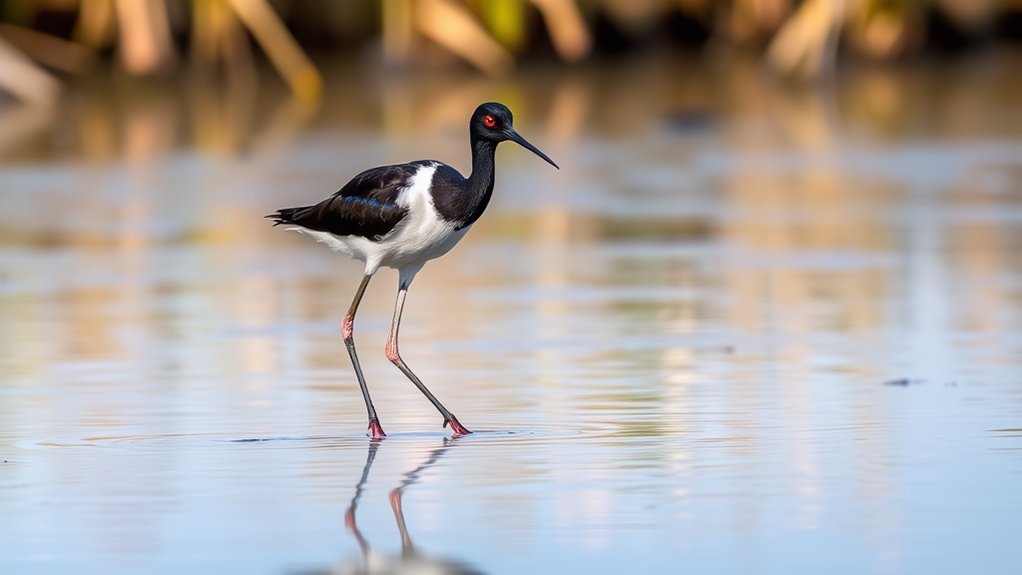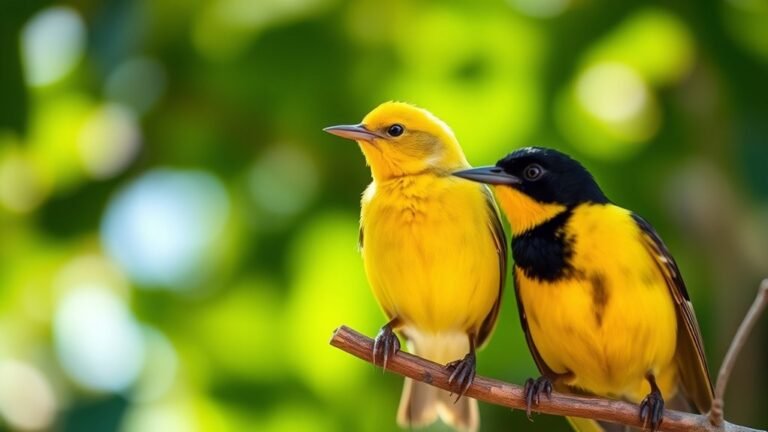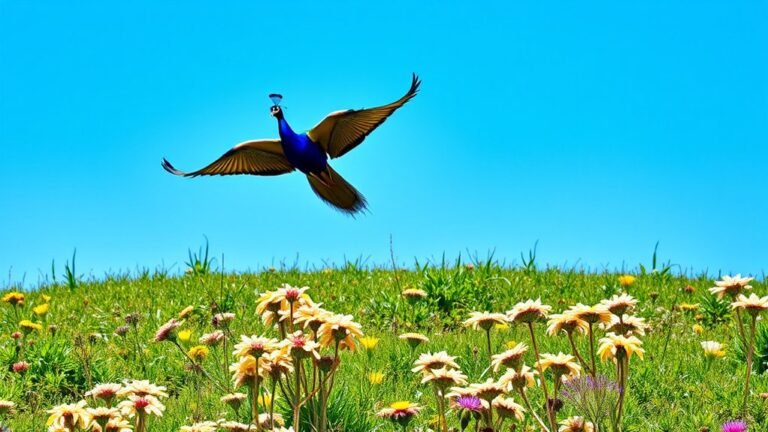Birds With Long Legs: Common Species Overview
When you look at birds with long legs, you will see some interesting species that love wet areas. The Great Egret, Sandhill Crane, and Black-Necked Stilt all have special ways of living in these places. Each bird has its own style of hunting and socializing that helps us understand the environment around them.
The Great Egret is known for its elegant shape. It stands tall and uses its long legs to wade through shallow waters while searching for food. The Sandhill Crane is a social bird. It often gathers in groups, where they communicate with each other using soft calls. The Black-Necked Stilt has striking black and white feathers and uses its long legs to catch small fish and insects in the water.
Watching these birds can tell us a lot about how healthy their homes are. If they are thriving, it means the wetland is in good shape. If they struggle, it might mean something is wrong with their environment. Each bird gives us a piece of the puzzle about the natural world we share. So, when you see them in action, remember they are not just beautiful; they are important for our planet, too!
A Quick Overview
Great Egrets are tall, white birds. They are very patient when catching fish in wetlands and marshes.
Sandhill Cranes travel in large groups. They dance and make loud calls to talk to each other.
Black-Necked Stilts have striking black-and-white feathers. They put on aerial courtship displays and enjoy socializing with each other.
Heron species, including the Great Blue Heron and Black-crowned Night Heron, do well in different wet areas. They have different ways to hunt for food.
Flamingos are known for their pink feathers. They like to feed in groups and dance together to bond and keep their environment healthy.
Great Egret

The Great Egret is a beautiful bird that stands tall with long legs and shiny white feathers. You can often see them in shallow waters, like wetlands, marshes, and lakes. These places are great for many plants and animals, making them important for nature.
Great Egrets are patient hunters. They can stand still for a long time, waiting for a fish to swim by. When they see one, they quickly snatch it up with their sharp beaks.
During courtship, Great Egrets show off their graceful movements both in the air and on the ground. They dance and fly in a way that's really mesmerizing to watch.
When you watch these egrets, you connect with nature. You get to see how all the parts of the ecosystem work together to support wildlife. This helps you feel more connected to the natural world around you.
Sandhill Crane
The Sandhill Crane is a tall bird with a special way of calling. They're interesting to watch because they mix elegance with friendliness.
During breeding season, these cranes perform fun dance moves. This dance shows how strong their connection is with each other.
When it's time to migrate, Sandhill Cranes travel long distances. They fly together in large groups, creating a beautiful sight in the sky.
They've a strong sense of community and communicate using loud trumpeting calls. These calls help them stay connected and organized while flying.
Learning about how Sandhill Cranes move and behave makes you appreciate these amazing birds even more.
Black-Necked Stilt

The Black-Necked Stilt is a beautiful bird that catches the eye with its long legs and striking black-and-white feathers. These birds love to live in shallow wetlands like marshes and flooded fields.
During breeding season, they show off interesting courtship behaviors. Males do aerial tricks to impress females. This often leads to them working together to build nests.
When you see a group of these stilts, notice how they interact. They like to nest near each other, creating a strong community.
Heron Species
Herons are interesting birds that look alike with their long legs, but each type has special ways of living and finding food.
For example, the Great Blue Heron likes to live in wet areas and shallow water. It has great skills for catching fish. You might see it slowly walking around to catch fish, frogs, or small animals.
On the other hand, the Black-crowned Night Heron is more active when the sun sets. It hunts for food at night, which helps it find dinner when most other birds are resting.
Herons can live in many places, like marshes and estuaries. This shows how they fit into different environments.
By watching herons, you can learn how they hunt and interact with each other. This helps us understand their important roles in keeping nature balanced.
Flamingo

Flamingos are special birds. They're known for their bright pink feathers and interesting way of eating. Their pink color comes from the food they eat, like algae and small shrimp.
When you watch flamingos, you'll see they like to feed in groups. They use their unique beaks to suck up water and catch food.
Flamingos usually live in shallow lakes, lagoons, and estuaries where the water is salty. These places help them survive.
They're very social and perform fun courtship dances, which help them build strong friendships with other flamingos. Their long legs help them walk through muddy water to find food easily.
Learning about flamingos helps us understand why they matter in nature. They help keep their environment balanced!
Avocet
Avocets are wading birds that live in wet places like marshes, mudflats, and estuaries. They've long legs that help them move easily in shallow water.
Avocets eat small creatures like insects, crustaceans, and tiny fish. Their special upward-curving bills let them sweep through the water to catch their food.
Watching avocets can help you appreciate wetlands and how important they are. These habitats support many animals and plants.
Wood Stork
Wood storks are unique birds known for their long legs and interesting nesting habits. They live in wetlands in the southeastern United States and Central America. These birds like to nest in groups close to water, where they work together to take care of their babies.
Wood storks eat fish, frogs, and small invertebrates. Their long legs help them wade through shallow water to find food. They use a special way of foraging that makes catching prey easier.
Watching these beautiful birds can help you appreciate how they fit into their ecosystem. They play an important role in the wetlands where they live.
Red-Breasted Merganser
Red-breasted mergansers are fascinating diving ducks. They've long, sleek bodies and strong legs that help them swim fast. You can often see them in lakes, rivers, and along the coast where the water is clear.
These ducks are great at catching fish. They dive under the water and use their sharp bills to grab fish quickly. Watching them dive is exciting! Their ability to hunt shows how well they fit into their environment.
Seeing red-breasted mergansers in action can deepen your love for nature. They play an important role in the ecosystem by keeping fish populations in balance.
Enjoying their presence can remind us of how all creatures are connected in the wild.
Lesser Yellowlegs
Lesser yellowlegs are beautiful shorebirds. They've long legs and slender bodies that make them easy to spot in wetlands like marshes, shorelines, and mudflats. These birds like shallow waters filled with life.
When you watch lesser yellowlegs feed, you see how they use their long legs to wade through the water. They carefully probe the mud for small creatures like insects and crustaceans. They often move quickly but also wait patiently, showing their skill in finding food.
Seeing a lesser yellowleg in action is a reminder of their important role in the ecosystem. They help show us how healthy the wetlands are. Each time you spot one, you can appreciate how special these birds are.
Frequently Asked Questions
What Habitats Do Long-Legged Birds Prefer for Nesting?
Long-legged birds like to nest in wetlands. These places have a lot of food and safety. When they build their nests, they often choose spots with thick plants or higher ground. This helps keep them safe from predators and makes it easier for them to find food for their babies. Nests in these areas help the birds raise their young successfully.
Are Long-Legged Birds Migratory or Sedentary Species?
Long-legged birds show different migration habits. Some of these birds can fly long distances because they have special wings and bodies made for travel. They move to find food or better weather.
Other long-legged birds stay in one place. They like to live in stable areas where they can find food and nesting spots.
Watching how these birds behave can teach us a lot about how they survive in their environments. Some take long journeys, while others make their homes in one spot. Each has its own way to thrive.
How Do Long Legs Benefit Birds in Their Environment?
Long legs help birds find food in different ways. With long legs, birds can reach deeper water and catch fish or other tasty treats that are hiding underneath. This makes it easier for them to eat.
Long legs also help birds stay safe from predators. They can run fast over different types of ground. This quick movement helps them escape from danger. Plus, having long legs means they can see better. They can spot dangers like cats or other animals looking to catch them.
In short, long legs make it easier for birds to find food and stay safe in their homes.
What Threats Do Long-Legged Bird Species Face Today?
Long-legged birds face big problems today. Their homes are getting smaller because of people cutting down trees and building things. Climate change is also a worry. This affects where they can find food and places to lay their eggs. As a result, many long-legged birds are seeing their numbers go down. It's important for us to help protect their habitats so they can survive and thrive.
Can Long-Legged Birds Exhibit Unique Behaviors or Rituals?
Yes, long-legged birds often have interesting behaviors! They show off during courtship by dancing and moving gracefully to attract mates. These fun displays make their partners pay attention.
Also, their feeding habits are unique. They use their long legs to wade through water or mud to find food. This special way of eating helps them survive in different places.

Luna is the passionate founder and author of Birds and You, a website dedicated to sharing her love for birds with fellow enthusiasts. Through her engaging articles and guides, she aims to educate and inspire others to explore the fascinating world of birds. When she’s not writing, you can find Luna observing birds in their natural habitats or sharing beautiful bird photography on Pinterest. Join her on this journey to celebrate and protect our feathered friends!







